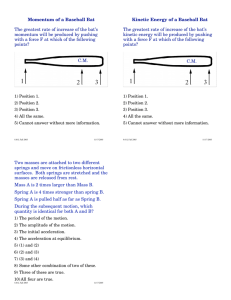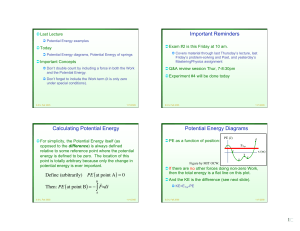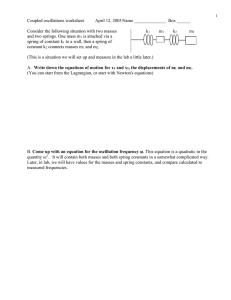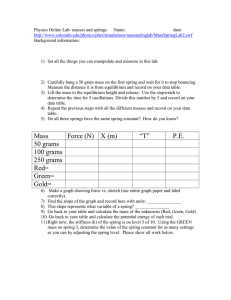Two masses are attached to two different
advertisement
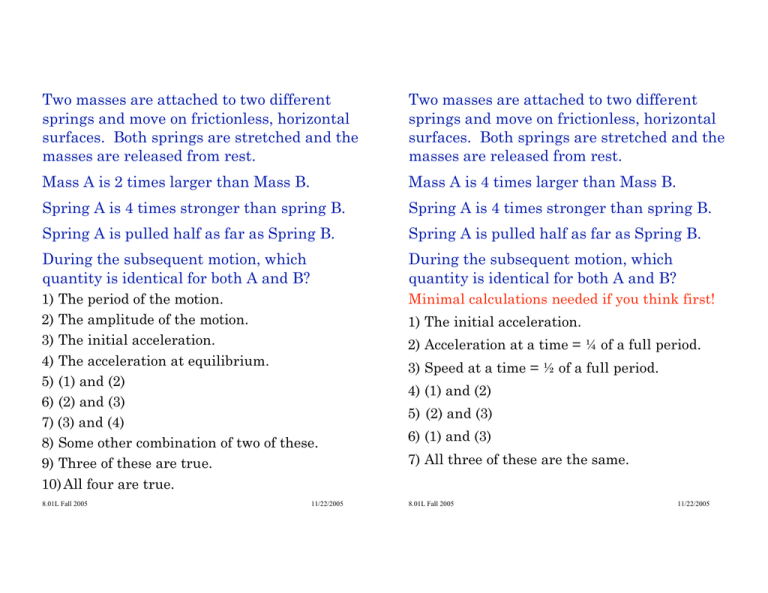
Two masses are attached to two different springs and move on frictionless, horizontal surfaces. Both springs are stretched and the masses are released from rest. Two masses are attached to two different springs and move on frictionless, horizontal surfaces. Both springs are stretched and the masses are released from rest. Mass A is 2 times larger than Mass B. Mass A is 4 times larger than Mass B. Spring A is 4 times stronger than spring B. Spring A is 4 times stronger than spring B. Spring A is pulled half as far as Spring B. Spring A is pulled half as far as Spring B. During the subsequent motion, which quantity is identical for both A and B? During the subsequent motion, which quantity is identical for both A and B? 1) The period of the motion. 2) The amplitude of the motion. 3) The initial acceleration. 4) The acceleration at equilibrium. 5) (1) and (2) 6) (2) and (3) 7) (3) and (4) 8) Some other combination of two of these. 9) Three of these are true. 10) All four are true. Minimal calculations needed if you think first! 8.01L Fall 2005 11/22/2005 1) The initial acceleration. 2) Acceleration at a time = ! of a full period. 3) Speed at a time = " of a full period. 4) (1) and (2) 5) (2) and (3) 6) (1) and (3) 7) All three of these are the same. 8.01L Fall 2005 11/22/2005 Two masses are attached to two different springs and move on frictionless, horizontal surfaces. Both springs are stretched and the masses are released from rest. Mass A is 4 times larger than Mass B. Spring A is 4 times stronger than spring B. Spring A is pulled half as far as Spring B. During the subsequent motion, which quantity is identical for both A and B? Minimal calculations needed if you think first! 1) The total mechanical energy at t=2 seconds. An object of mass M is sliding with speed V on a frictionless, horizontal surface. It collides with an identical mass which is attached to a spring of spring constant k which is initially unstretched. After the collision, the two objects stick together and begin to compress the spring. Predict where and when the objects will first come to rest in their subsequent motion. 2) The kinetic energy at t=2 seconds. 3) The speed at t=2 seconds. 4) (1) and (2) 5) (2) and (3) 6) (1) and (3) 7) All three of these are the same. 8.01L Fall 2005 11/22/2005 8.01L Fall 2005 11/22/2005 An object is attached to a vertical spring which is initially unstretched. First, the object is slowly lowered to its equilibrium point. You observe that the spring is stretched a distance d at this point. Next, the object is raised back up to the initial point where the spring was unstretched and released from rest. You do this experiment on the surface of the Earth but have only the one measurement. Predict where and when the object will first come to rest in its subsequent motion. 8.01L Fall 2005 11/22/2005
